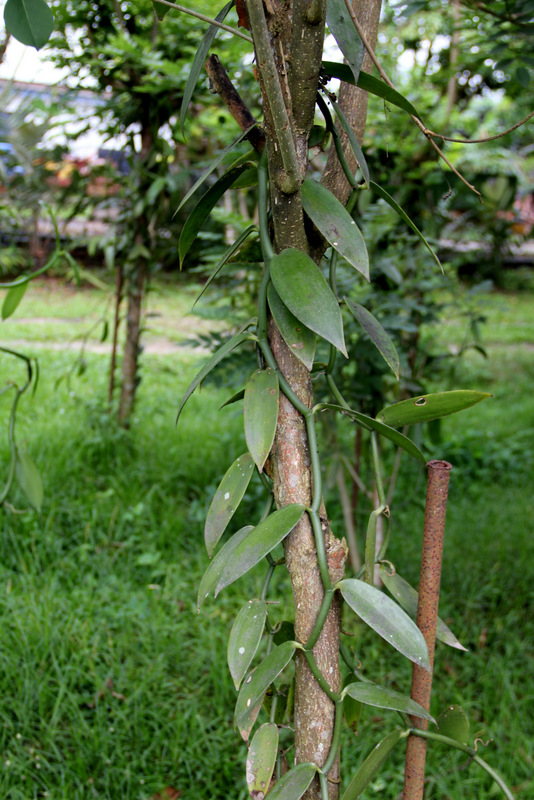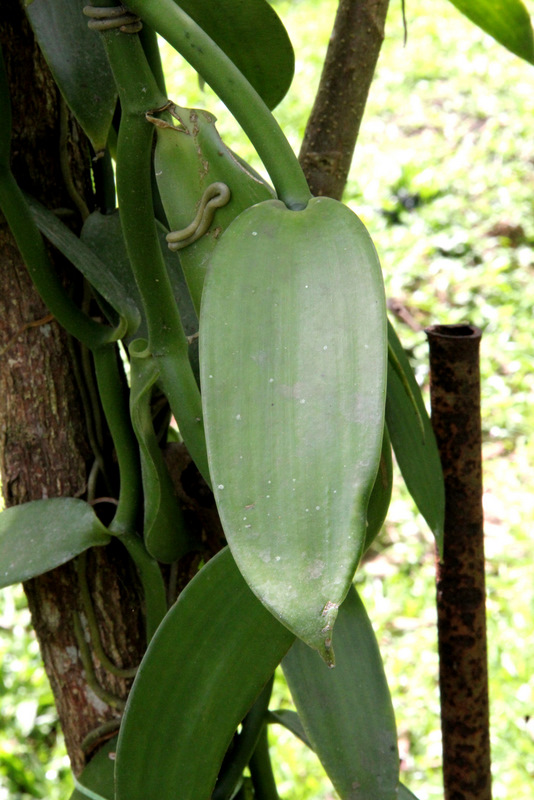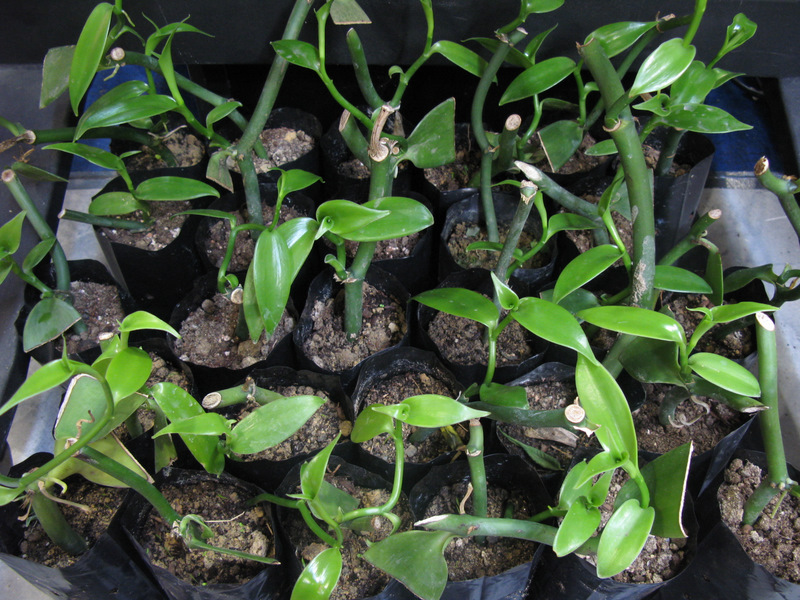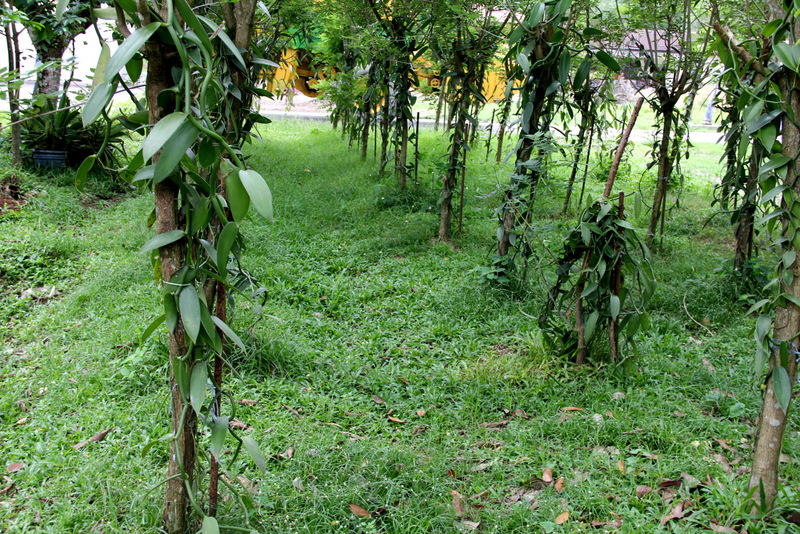Botanical Names
Vanilla planifolia
Common Names
| Malaysia | Vanilla |
| English | Vanilla |
Family
Orchidaceae
Introduction
‘Vanilla’ is native to Mexico. It is now widely grown in the tropics. Madagascar is the world largest producer of vanillin, which is mainly obtained from the species Vanilla planifolia. Others species includes Vanilla pompona and Vanilla tahitiensis. Vanilla is one of the most expensive spices due to the extensive labour required to grow the seedpods. It is highly valued for its flavour and widely used in both commercial and domestic baking, perfume manufacture and aromatherapy.[1][2]

Morphological Features
‘Vanilla’ grows as a vine, climbing up an existing tree, pole, or other support. The stems are cylinder in shape, green in colour measuring about 1.5 cm in diametre. The leaves are borne at each segment of the stem. The leaves are glossy green in colour. The new branches and flowers are also developed at these segments. The flowers are yellowish green in colour and have a very pleasant smell. The fruits are triangular in shape, dark green in colour when young and turns yellow when it starts to mature. It measures 10-25 cm in length depending on the vigour of the crop.[1]

Medicinal Properties and Usage
‘Vanilla’ is planted to produce vanillin that is normally used as the flavouring agents in the food industry especially ice-creams, chocolate, custard, caramel, coffee and others. It is also used in the cosmetic industry to make perfumes. Traditionally it is used as an aphrodisiac and remedy for fevers and to retard the spreads of bacteria. The essential oils produced are sometimes used in aromatherapy.[1][2][3][4]
Soil Suitability and Climatic Requirement
‘Vanilla’ is best suited to well-drained alluvial soil with high organic matter content. It requires well-distributed rain during planting and growing with a total of 2,500-3,000 mm annually. For maximum growth, it requires about 40-60% shade. Thus, it is well suited for planting under agroforestry conditions. Artificial shade is required if planting is to be done at new areas.[1][2]
Field Preparation
Land Preparation
Good land preparation is very important for good crop growth. For a new area, the soil has to be ploughed once with a disk plough followed twice using a rotovator. It is very sensitive to waterlogging and thus it is best planted on beds. The recommended bed size is 60 cm wide (furrow to furrow) and 30 cm high. The planting pole and shade structures using black netting should be prepared for planting on new production areas. Planting can also be done under-agroforestry conditions where the existing shades are benefited. The recommended planting distance is 1.5 m both between rows and between plants in a row. This will give the population density of about 4200 plants/ha.[1][2]
Production of Planting Materials
‘Vanilla’ can be propagated either by using stem cuttings or tissue culture techniques. Cutting measuring 60-120 cm should be selected from the vigorously growing unflowered portion of the vines. These cuttings can be directly planted into the field. The shorter cuttings should be first raised in the polybag before being planted in the field. Longer cuttings will takes shorter time for the plants to start flowering. The seeds are seldom being used as the source of planting since they are very small and take much longer time to develop into matured plants.[1][2]

Field Planting
The planting pole and shade structures using black netting should be prepared for planting on new production areas. Planting can also be done under-agroforestry conditions where the existing shades are benefitted. The recommended planting distance is 1.5 m both between rows and between plants in a row. This will give the population density of about 4200 plants/ha. [1] [2]

Field Maintenance
Fertilisation
Both the organic and enriched organic fertilisers should be used in the production of vanilla. Chicken manure can be used as the source of organic fertiliser. The recommended rate is 4-5 t/ha to be applied about a week before planting. The enriched organic fertiliser having the ratio of N:P:K=12:12:17 should be applied around the planting point at the rate of 500 kg/ha at 6 months intervals.[1]
Weed Control
The plant is very sensitive to pesticides and thus the weeds are normally controlled manually by using grass cutters. The organic mulch such as dry grasses are given around the planting points to control weeds. The mulch also helps to conserve moisture and reduce the soil temperature, especially during the drier months.[1]
Water Management
‘Vanilla’ grows well under wet and moist growing conditions but not under flooded conditions. Thus supplementary irrigation by using the drip system is recommended during the drier months. To avoid transplanting stress, field planting should be done at the beginning of the rainy seasons.[1]
Pest and Disease Control
The most common diseases are bacterial stem and leaf rots. These diseases can be managed by practicing good sanitary practices. Reducing the shade intensity and thus the ambient moisture can also help to contain the spread of the disease. There is no serious pest infesting vanilla recorded.[1]
Harvesting
The beans should be harvested once it is fully matured. The matured pods are pale yellow in colour at distal ends. At this maturity stage, the pods begin to split on the end. Each pods matured at different times. For maximum quality, harvesting of the pods should be done daily. The pod yield largely depends on the care and management given to the hanging and fruiting vines. A five-year-old vine can produce between 1.5 and 3 kg pods and this production can increase up to 6 kg after a few years.[1]
Postharvest Handling
Post harvest handling or curing of the vanilla involved 4 stages that is killing, sweating, slow-drying, and conditioning of the beans. The vegetative tissues of the vanilla pod should be killed to prevent further growing. This is normally done through sun drying. Sweating is the process of wrapping the beans in woollen cloth to raise the temperature (45-65oC, under high humidity) of the beans under sunlight conditions for about one hour to a few days. The pods are then kept in wooden boxes under airtight conditions. The procedures will allow enzymes to catalyse the reactions involved in generating the characteristic vanilla colour, flavour and aroma.[1]
Estimated Cost Of Production
The total cost of production for a hectare of vanilla is about RM175,000.00. This includes the cost of planting materials, shade structures, irrigation systems, agriculture inputs and labour. With the fresh yield averaging 16 t/ha/year, the cost of production is about RM10.00/kg. The production cost was estimated based on the cost of current inputs during writing of this article.[1]
References
- Anon 2010. Kertas maklumat penanaman vanilla. Kuala Lumpur : Department of Agriculture Peninsular Malaysia (unpublished)
- Mohd Noh A. J. (1998). Penanaman vanilla – Laporan Khas. MARDI : Serdang
- Mohd Noh A. J. (1999). Vanilla – “Emas hijau” perisa berharga. Agromedia Bil. 6. MARDI : Serdang
- Anon (1994). Penanaman Vanilla. Laporan lawatan sambil berlajar Ahli Jawatankuasa Bertindak Pertanian Negeri Sembilan ke Indonesia. Jabatan Pertanian Negeri Sembilan


